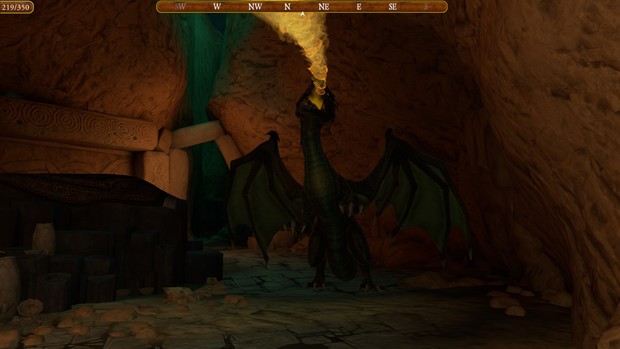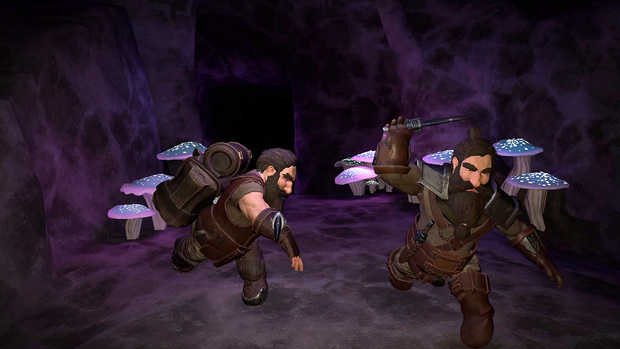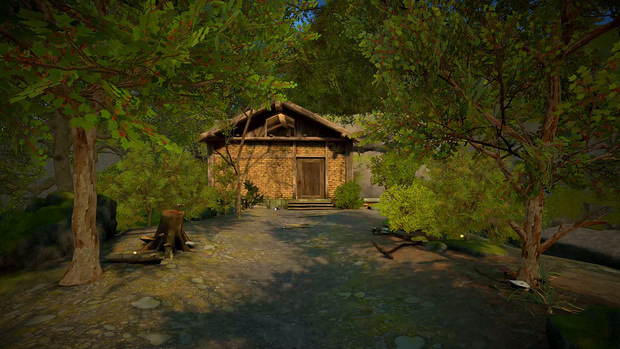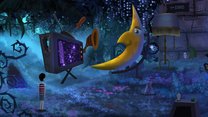Colossal Cave – Reimagined by Roberta Williams review – The iconic text classic unearthed in graphical 3D

- 3 Comments
The newly remade and reimagined Colossal Cave starts with a simple question: Would you like instructions?
It punishes you if you say yes. You may not even notice, but your score will start out 5 points lower than it otherwise would, and this first important choice – before you even find yourself navigating the 3D world at all – determines whether you’ve got a fighting chance at beating Colossal Cave “properly,” or whether your hopes are doomed from the outset. This initial impression aptly foreshadows just how much this game is decidedly not on your side.
Of course, veterans of the original Colossal Cave know it isn’t about winning on your first go, but constantly faceplanting in a bewildered stupor until you find yourself making something resembling incremental progress across many playthroughs. It doesn’t matter how good you are: if you’re going in blind, your first run through Colossal Cave will almost certainly not be a win. At best, you can expect to explore most of its labyrinthine passageways and solve a few of its many puzzles if – and it’s a big if – the randomized, unseen dice rolls go your way. And honestly, it’s best to quell any expectations of succeeding on a second full playthrough either… or third, or even the fourth, or…
Hold the dang phone, what kind of twisted game is this?! Perhaps a little history is in order.
In 1976, Colossal Cave Adventure (or simply Adventure, as I’ll refer to it from here on) was released by computer programmer and spelunking enthusiast William Crowther. The earliest example of the genre that would later adopt its name, it was a text-only experience that combined exploration with puzzle solving and could be played with a printer if you didn’t have a monitor. Despite only being available on enterprise-level mainframe systems rather than home computers (at least at first), Crowther’s creation quickly spread across networks far and wide, eventually catching the attention of programmer and self-described hacker Don Woods. Woods was enamored with the game and received Crowther’s blessing to expand upon the design with more areas, objects, and a plethora of high-fantasy elements that would cement its legacy. It was this 1977 version of Adventure that set off a cultural revolution, inspiring a wave of similar titles like Zork and Rogue.
In 1979, long before her status as a titan of the game industry was established, Roberta Williams was an unknown (and reluctant) systems programmer who yearned to put her imagination for storytelling to good use. When she happened upon Don Woods’s take on Adventure, she was instantly won over and her life course swiftly changed forever. Roberta persuaded her husband Ken to help her program their own game in a similar vein (which became 1980’s Mystery House) but with visuals added, pioneering the graphic adventure genre as we know it today. The pair released the game under the self-made company that would soon become Sierra On-Line, leading the genre to legendary success for nearly two decades.
After Sierra was sold off in a much-documented kerfuffle, Roberta and Ken retired from making games in 1998 and completely disappeared from the industry. But now they have returned. Over forty years after first playing Adventure, Roberta and Ken have gone back to their roots to recreate the game that inspired their own passion for becoming adventure game power players, reimagining this seminal piece of videogame history through their own lens. This Colossal Cave has been built from the ground up in first-person free-roaming 3D for the first time, with the daunting text parser replaced by a simplified mouse-driven (or gamepad-based) control scheme – and in keeping with the times, it’s also available in VR. Roberta has added subtle narrative touches to enhance the story and atmosphere, but otherwise the game is about as faithful to the original as a fully graphical remake could be. The result is a fascinating and impressive act of videogame preservation, though not without its flaws: most very old, some brand new.

The objective feels simple enough: explore the cave, find all 15 treasures, and take them back to the aboveground wellhouse where your journey began. Complicating matters is your finite inventory, as you’re only able to carry so many treasures (and other useful objects) at a time. This means you’ll have to make several trips back and forth from the wellhouse to the very depths of the cave, prioritizing which objects you’ll need for which encounters — all while contending with a continuously depleting lantern battery. You can trigger a less-than-satisfying endgame just by getting close enough to the treasures to interact with them all, but winning the game properly requires hauling each one of them back to the surface as well, in a very limited number of moves.
By leaving the underlying gameplay almost untouched, 2023’s Colossal Cave harkens back to an era of punishingly difficult game design, where the only way to achieve a completionist 350-point victory requires loads of false starts and devastating defeats. And I don’t just mean the “oh, that mistake killed me, better reload a save from a minute ago” type of game over, but the far more twisted “oh… by picking up all the items in the very first location, I’ve pretty much set myself up for an unrecoverable failure” flavor.
This is a game that you can only beat by having the knowledge from previous attempts to help you formulate a proper strategy. You could easily spend several weeks (or months) stumbling through the cave via trial and error, occasionally stewing on the logic in the back of your mind between play sessions and coming up with new ideas to try before a rewarding “aha” (or a dumbstruck “that’s what you’re supposed to do?!”) finally strikes.
This aspect alone is likely to put many players off, while drawing in others based on the intoxicating lack of handholding. I belong more in the former camp than the latter… but I’ve got to admit that there’s a fascinating and frankly mythic quality to the game’s uncompromising difficulty. It runs on some bewildering and strangely archaic logic that initially put me off, but as I played and replayed (and replayed), I gradually warmed up to it more than I expected to. There’s a good reason the original game has had such staying power, and that dash of Roberta Williams magic this time around certainly doesn’t hurt.

Still, some are likely to throw up their hands and curse the whole thing as they abandon it for good – as I was nearly ready to after my first few attempts. The adventure genre has long been accused of unfair design and “moon logic” puzzles, but Colossal Cave Adventure wrote the book on how to be a right scoundrel to its poor players.
For example, there’s a handful of spells you can learn as you comb through the cavern, one of which – the famous “PLUGH” – is a teleportation ability that’s only added (or not) to your repertoire by random chance as you enter one specific room. How random are we talking? Well, maybe you’ll get lucky and get it on your first entry. Or maybe you’ll go through the room a half dozen times and be given squat, and wrongly (but reasonably) assume the room is a dead end with no purpose, never to return. Oh, and there’s no clue about the spell’s existence. You either receive it or you don’t. And if you don’t have it, you pretty much can’t win.
If a puzzle like this was in an original new adventure game, I’d cry foul for sure. But because we’re talking about an accurate restoration of the very first adventure game ever made? Well … I may not be a huge fan of the randomized logic, but the historical significance makes me more willing to cut it some slack. Not all the puzzles are so unfair (I quite loved one that involved making use of a befriended bear), but a healthy portion of them march straight into hair-pulling territory.
Random chance fuels tons of interactions in Colossal Cave, making it hard to pigeonhole into a neatly defined genre. There are hostile dwarves that can appear at any moment and potentially end your game with a lucky knife throw – though it took me over a dozen encounters with them to finally learn that their wildly inaccurate aim doesn’t always miss – and most frustratingly, many cave passages don’t necessarily lead where they’re usually supposed to, resulting in another unseen dice roll to determine if you successfully advance or stumble right back out to where you just came from. It’s never clear whether that’s due to some magical aspect of the cave or just meant to represent your character getting lost and turned around, but it results in a big underlying issue: if you go through the same exit a few times in a row (and are unlucky enough to keep ending up back where you were), it’s reasonable to assume that exit is never worth trying again… when in fact, it might be essential to your progress. Between the luck-of-the-dice exploration, unclear puzzles, and random encounters with (very) light combat elements, it all adds up to feel like a cross between a book of brainteasers and a particularly laborious Dungeons & Dragons session – resembling both a trickier Myst and a loose progenitor to the Elder Scrolls series in equal doses.

On one playthrough, I got so close to finally beating the darn thing, but in the last steps to obtain the final treasure, my lamp went out and my whole excursion came to an abrupt conclusion. In a game entirely themed around exploring a massive cavern, I had apparently made the unforgivable error of choosing to explore ever so slightly too much.
As it turns out, the ultimate puzzle of Colossal Cave is mapping out the most efficient route one can possibly take to hit all the key areas in the right order. To win (and by win, I mean getting every point possible), you need to essentially speedrun the game – finding the shortest paths between each treasure and hoping that a random encounter with the booty-stealing pirate doesn’t trigger at an inopportune moment. There isn’t one exact order that you have to do things, but by and large, successful runs won’t look much different from each other.
Thankfully, there are a number of things the remake does to curb the original’s infamous difficulty, at least a little. First of all, there’s automapping! Adventure practically necessitated a pen-and-paper approach to gain a lay of the tunnels and rooms and how they all fit together, but Colossal Cave does explorers a big favor by keeping track of everywhere you’ve gone. While I can appreciate the hardcore tradition of taking real-world notes to solve old games, I’m immensely grateful that this newfangled quality-of-life feature made that optional. Encountering a passageway that randomly sends you back the way you came will still be confusing, but at least the map tells you where it’s supposed to lead (once you’ve made at least one successful trip through it).
Furthermore, by switching to a keyboard/mouse-driven (or even mouse-only) interface instead of a text parser, the number of possible actions you can take with objects is always made very clear, rather than making you guess from an unknown dictionary of verbs. While some may cry foul that this takes away from the identity of the original, I appreciate that it curtails a bit of frustrating guesswork. A few of Adventure’s most confounding puzzles involved crafting commands with very odd or even nonsensical wording to proceed, and Colossal Cave has done a nice job of cleaning up these eccentric moments.

It falters, however, by making certain interactions more fiddly or even more difficult than the original. I had a lot of trouble trying to climb up a giant beanstalk unless I approached it from a VERY specific angle before clicking, which made me think I’d missed part of the puzzle at first. Similarly, the path to a jeweled trident is now much trickier to find thanks to some pretty subtle landscape detail. And the infamous “mazes of twisty passages,” probably the most time-consuming areas of the original game – yes, there are mazes within the maze, which feature anywhere from three to ten exits at each junction – take longer to navigate here due to the slower pace of moving in 3D space, as opposed to quickly typing a cardinal direction in the text version.
It’s worth pointing out for those who played the original Adventure that depending on when you did, you might not see all the content you’d expect to find here. This Colossal Cave is a recreation of the famous 1977 release, not any of the subsequent expansions that Crowther and Woods made to the game up until 1995. I don’t consider this a negative because the scope of the game feels just right as is, but if you’re a player who got really attached to areas added later on (like the forest maze), you should set your expectations accordingly.
Colossal Cave’s new graphics aren’t anything revolutionary, but some of the rooms look quite nice. I was especially fond of the large, open cavern resembling Swiss cheese, and a nearby chamber where the cave walls are bathed in a trippy glow from phosphorescent fungi. There are a lot of nicely animated touches enhancing the atmosphere, too, from the thirsty beanstalk’s bouncy wiggles to the flying bats you’ll disturb as you cross the canyon wall.
The one area of the remaster that feels really lacking is its audio. I greatly enjoyed the narrator (he’s pitch perfect) and the small smattering of voiced lines from other inhabitants of the cave, but beyond the occasional sound effect or subtle cavern ambience, there is surprisingly little going on – bafflingly, not even the sound of the player’s own footsteps. You can sprint through the roughest, rockiest terrain in the cave’s introductory “cobble crawl” section and not hear a single thing aside from a low, distant drone of wind in the background. It makes the game feel far more lifeless than a modern remake would suggest.
Similarly, music is used sparingly and I wish there was more. The score seems to be entirely comprised of pre-existing classical pieces rather than any original compositions. Music is specific to key locations, triggering when you enter for the first time. Unfortunately, the pieces are all quite brief, and in the PC version I played, songs abruptly cut off if you open your map or inventory, which isn’t so nice. Once a piece plays (even if interrupted), it’ll never trigger again during your playthrough. It’s a shame – more music could have been a way to add a bit more atmosphere during return trips.
Thankfully, despite some cut corners, the game’s got a decent amount of polish overall. It’s well-optimized, the inventory looks sharp, and it sports some pretty short load times and undemanding system requirements.
The VR edition, currently a separate product available for Meta Quest 2 headsets (but scheduled to be added to the PC version at a later time) is an impressive release with a few quirks of its own. The graphics and atmosphere really get to shine here, and I was surprised by just how much better the art style works on a headset versus a flatscreen. Compared to most other Quest titles, Colossal Cave looks fantastic here. That said, while having 360 degrees of exploration adds a ton of immersion, it doesn’t always pan out for the best. There are two locomotion options, but both involve free movement, so there’s no teleport option so common in VR games, meaning motion sickness is likely to kick in after a short time for anyone sensitive to it. You can play sitting or standing equally well, but the controls can be a little awkward and may not always move you in the direction you intend to go. And when pulling up my map, it would often appear behind me and require a full about-face to view. You also can’t sprint in the VR version – probably a wise concession to avoid heightening motion sickness further, but it does make the pace of exploration feel pretty glacial. Thankfully, the music glitches plaguing the PC version weren’t present on the Quest, giving me hope that they’ll be fixed on all platforms sooner or later.
Final Verdict
As it turns out, Colossal Cave is almost as difficult to review as it is to solve. Every time I thought I’d made up my mind about it, I’d play a bit more and feel conflicted once again. On one hand, it’s an impressive bit of historical preservation, serving as a quality remake of a legendary game. On the other, it’s still a frequently confounding experience that nearly drove me nuts at times (and will probably test the average player’s patience more than any new modern game could get away with). Nonetheless, there is something that just feels pleasantly “right” about Roberta and Ken Williams making games again. Here’s hoping that Colossal Cave won’t be the last time we see the (rather lovely) Cygnus Entertainment logo preceding an adventure game in the 2020s and beyond.
Hot take
It’s brutal and baffling, but unmistakably Colossal Cave. It may not have wide appeal for today’s audiences, but this charming reimagining by Roberta and Ken Williams pays tribute to a classic piece of gaming history with the added bells and whistles of modern magic.
Pros
- Strikes the tricky balance of vastly revamping yet faithfully preserving the world’s first adventure game
- New control scheme is a welcome replacement to the original’s text parser
- An excellent, ever-present narrator
- Exploration is still fun all these years later, especially in VR
Cons
- So faithful it retains some of the most unfairly difficult puzzle design in adventure game history, with too much reliance on random chance
- Veteran players may lament the loss of the text parser option
- Surprisingly little sound design, giving a barren vibe to many areas
Sean played Colossal Cave primarily on PC and tested the VR version on Meta Quest 2 using review codes provided by the publisher.

- Advertisement
- Help support AGH by advertising with us











3 Comments
Want to join the discussion? Leave a comment as guest, sign in or register.
not 69 points :(
Reply
This review was extraordinarily well written and made for a top-to-bottom enjoyable read. This is the kind of game that might have been up my alley as a youngster with enough free time to derive satisfaction from mathing everything out and figuring out the optimal way to beat the game. When I had enough free time that hours of frustration would be redeemed by wandering into that one room just one more time and learning the PUGH spell, and things like that. As an adult who still has time to play and still enjoys being stumped by *good* puzzles, I still have no time for games like this which don't seem to respect the players time. We should be playing with the game; the game shouldn't be playing with us. I'm a huge fan of King's Quest and most of the Sierra oeuvre, but I don't revere Roberta Williams as a game designer. Her classics, for the most part, worked because of their atmosphere, graphics, and simple but exceedingly charming stories. The gameplay was never all that great, although fortunately I was too young and captivated by the aforementioned qualities to notice, back in the day. Glad to see she's making games again, and I'd gladly try the next one, so long as it isn't something like this.
Reply
Hey all, this is the reviewer just popping back (a whole month later) to note that a recent update of the game fixes a fair number of the gripes I had in my review. I'm no longer experiencing music glitches and there's a much better "prep screen" where the overall logic of the game is better explained, which details what happens if you do (or don't) take the instructions at the beginning, amongst a host of other tweaks explained in full on the Steam page. They're all solid changes and the game is noticeably better for them. I don't believe site policy is to update reviews, as it's much too difficult for our staff to keep on top of playing all the current releases as it is, but if I were to re-review this, you could expect a score a few points higher.
Reply
Leave a comment